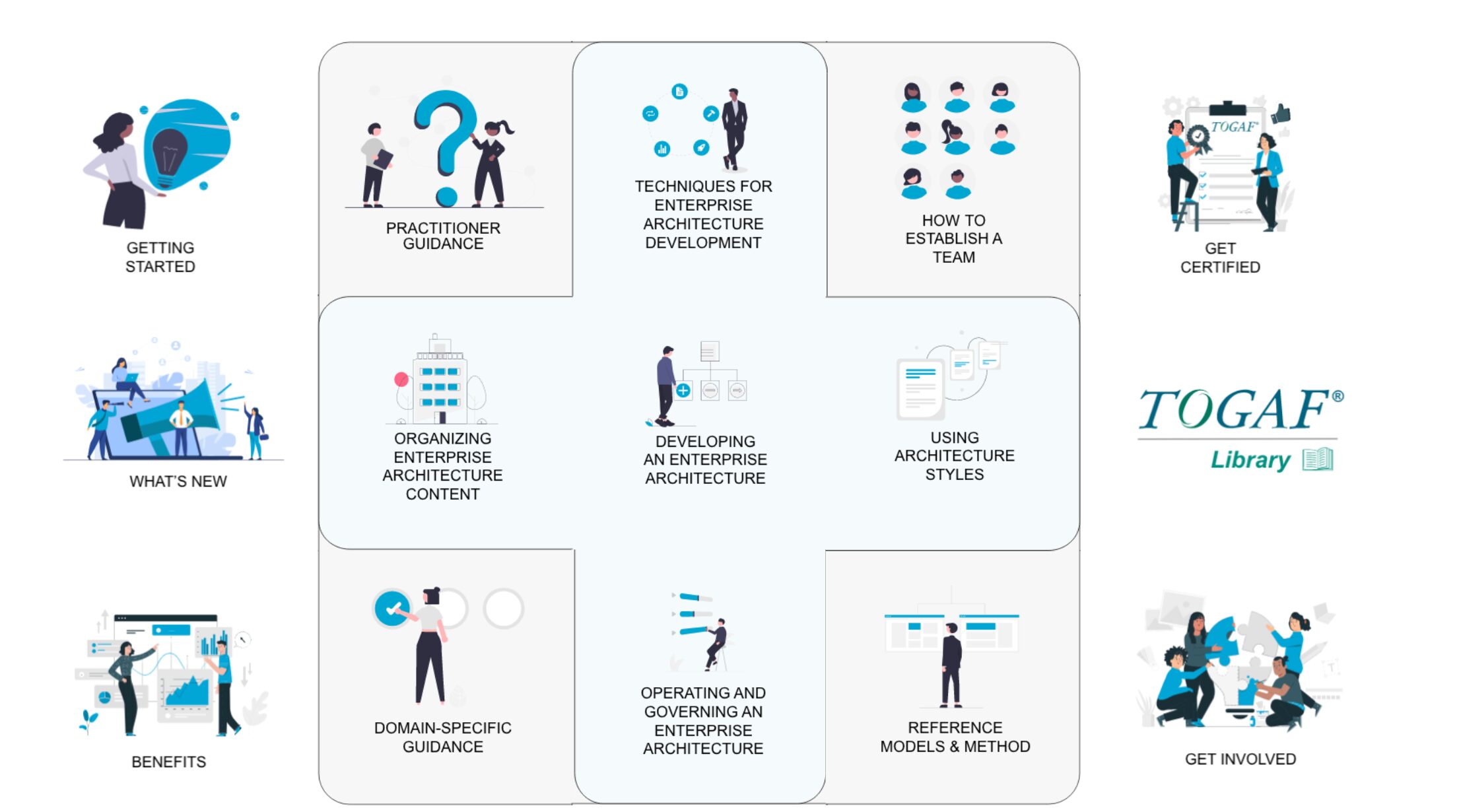Learn how to maximize the value, professionalism and accuracy of your Solution Architecture by leveraging Enterprise Architecture frameworks.
In this guide, we discuss the use of enterprise architecture frameworks and methodologies in the context of solution architecture.
Collaboration between enterprise and solution architects is essential for successful digital transformation, and effective day to day management of the organization. In short, Enterprise architects help provide a strategic context, guiding principles, and standards for solution architects to align their solutions to.
Solution architects, in turn, provide hands-on experience, technical expertise, and practical solutions that enterprise architects can leverage to support enterprise transformation initiatives. By working collaboratively, enterprise and solution architects can ensure that all solutions align with the overall business strategy, standards, and governance principles or the organization.
To maximize this collaborative power of this relationship, it is advisable for solution architects to adopt frameworks and methodologies that create a common language and approach.
Solution architects typically use architecture frameworks that are widely adopted in enterprise architecture management.
TechTarget explains that …”An enterprise architecture framework often segments an architecture into layers, architectural views or domains based on core application logic. Since there are many types of enterprise architecture designs to implement, the benefits of an enterprise architecture framework typically become more apparent as the complexity and diversity of the architecture increases.” [1]
While these frameworks are designed to handle the complexities of even the most intricate organizations and their changes, they can also be generic. Regardless of your chosen enterprise architecture framework, customization will likely be necessary to tailor it to your organization’s needs.
In this guide, we’ll focus on the most popular and well-known frameworks (although there are others): TOGAF and ArchiMate.
RELATED WIKI: Comparison of enterprise architecture frameworks
TOGAF:
The Open Group Architecture Framework or TOGAF [2] is a framework for Enterprise Architecture that introduces the Architecture Development Method. This approach helps organize the development process systematically to reduce errors, maintain timelines, and stay on budget.
Solution architects may use TOGAF for several compelling reasons:
READ: What is TOGAF and why should organizations use it?

Source: The Open Group – The TOGAF® Standard, 10th Edition
ArchiMate:
ArchiMate is a powerful visual language (not strictly an architecture framework) used for the design and modeling of an entire organization, including the solution architecture. It offers a comprehensive set of concepts and notations that allow architects to depict and analyze the architecture’s structure, behavior, and relationships.
ArchiMate enables enterprise architects to model from strategy and goals to execution
DOWNLOAD: Free ArchiMate 3.2 elements and relationships poster
ArchiMate and TOGAF
Solution architects often use TOGAF and ArchiMate together. TOGAF provides a comprehensive approach for achieving alignment in enterprise architecture practices. At the same time, ArchiMate, an open and independent modeling language, offers a powerful tool to visualize and communicate complex architectural concepts.
The two standards complement each other. ArchiMate provides a vendor-independent set of concepts and graphical representation that helps create a consistent, integrated model, which can be depicted as TOGAF views [3] [4].
For more information on using TOGAF and ArchiMate together, click here [4].
Why would solution architecture teams adopt frameworks in the first place? What’s the relevance of these frameworks? There are many reasons teams adopt a framework.
The most obvious reason is that frameworks provide a structured approach to managing complexity and ensuring consistency. Miscommunication and a lack of collaboration is a huge problem among teams in organizations with large, complex systems.
Enterprise architecture frameworks also establish clear guidelines and best practices, streamlining architectural development and reducing the risk of making ad hoc decisions that could lead to inefficiencies and the need for rework.
Frameworks can offer a standardized language and notation system. Misunderstandings are minimized by employing a shared vocabulary, and decision-making becomes more informed and efficient.
READ: How Anglian water has adopted ArchiMate and Entity Relationship Diagrams (ERDs)
Using frameworks enables better alignment between business objectives and architectural initiatives. Frameworks provide methodologies to assess current capabilities, identify gaps, and create transformation roadmaps. This alignment strengthens the position of enterprise architects as strategic enablers within the organization.
Frameworks foster consistency and reusability across architectural artifacts and solutions. With a well-defined structure, architects can organize their work and create modular designs that can be easily reused in different projects.
Finally, frameworks provide guidelines for governance, ensuring that architectural decisions adhere to established standards and comply with industry regulations.
(Source) Enterprise architecture tool Bizzdesign Horizzon helps solution architects produce solution architecture designs with out-of-the-box templates
A more streamlined way to adopt architecture frameworks is to use an enterprise architecture tool, which includes solution architecture templates to support you in creating and communicating solution architecture designs.
The templates are designed to provide a structured process for creating and communicating solution architecture designs, and they are based on reliable, connected metamodels such as ArchiMate, UML, ERD, and more. These templates aim to speed up design work, raise the bar on quality and impact, and ensure a great design experience for solution architects and their stakeholders.
Source: Bizzdesign Horizzon – Bizzdesign Horizzon, an enterprise architecture tool, provides guided solution architecture design with standardized templates
Solution architecture framework implementation involves steps to ensure an organization’s successful adoption and utilization.
RELATED WIKI: Implementing an enterprise architecture framework in your organization
By following these steps, you can effectively implement a solution architecture framework and leverage its benefits in designing and implementing IT solutions:
It is important to consider agile development techniques when discussing solution architecture frameworks and methodologies. Agile development practices are characterized by iterative and incremental development, where requirements and solutions evolve through collaboration between self-organizing cross-functional teams.
Agile promotes adaptive planning, evolutionary development, early delivery, and continual improvement, encouraging rapid and flexible responses to change. These practices are inherently synergistic with solution architecture methodologies that embrace change and adaptability.
Solution architecture methodologies within an Agile context ensure that the high-level structure of software systems and the discipline of creating such structures are cohesive with Agile values. They focus on the collaborative creation and evolution of system architectures to serve as a guide for development teams.
Instead of creating a fixed architecture upfront, the solution architecture in Agile is developed iteratively, allowing architects to refine and adjust the architecture based on feedback from each software development iteration. This way, the architecture is designed to accommodate changes rather than resist them, ensuring that the final system is robust and flexible, capable of supporting current and future business needs.
Agile Enterprise Solution Architecture aims to provide holistic yet pragmatic modeling to enterprise information systems and an incremental and iterative approach to agility. This approach helps solution architects clarify enterprise-level issues and key stakeholders’ major concerns [5].
Sources
[1] https://www.techtarget.com/searchapparchitecture/definition/enterprise-architecture-framework
[2] https://publications.opengroup.org/g21e
[3] https://pubs.opengroup.org/architecture/archimate301-doc/apdxd.html
[4] https://www.opengroup.org/togaf/10thedit
[5] https://blog.opengroup.org/2021/07/20/agile-enterprise-solution-architecture/
[6] https://scaledagileframework.com/development-value-streams/

Biography:
Joe Ewing is an experienced Enterprise Architect with expertise in Risk Management, Business Analysis, and Compliance. He excels in fast-paced consulting, working in various sectors like Secure Government, Energy, and Banking on transformative projects. Before Bizzdesign, Joe was a Senior Enterprise Architecture Consultant at Deloitte and ATOS, leading projects like Digital Workplace Transformations and M&As.